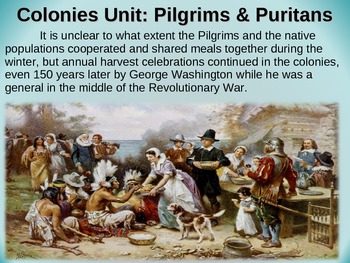
Within a century of their communities’ founding, residents turned to export trade, watered down the standards for church membership, accepted more religious diversity, fought over a variety of issues, increasingly eluded community punishment for their sins, and left town. As the towns grew and connected to the outside world, residents became more divided and less deferential to the elites – a trend that exploded in, for example, the Salem witchcraft trials of the 1690s.

Moreover, these Puritan societies did not last long. (For more detail, see Made in America, Ch. and achieve a degree of communal unity virtually unknown in the fluctuating world of early modern England.Ĭolonists almost everywhere else in 17th and 18th-century America lived in far more unorganized, disorderly, and diverse places. suppress individual deviance and sin, exert tight control over the unruly forces of the market, diminish acquisitiveness and the covetousness or frivolous indulgence it engendered, locate every person in an appropriate calling. Jack Greene has explained that the Puritans Magistrates compelled Sabbath attendance and suppressed religious alternatives, to the point of executing dissident Quakers. In one town, 20 percent of the adults in each decade found themselves charged with an offense, usually a morals violation. They controlled individual behavior by fierce gossip, defamatory and often obscene billboards, and court suits. In the mid-1600s, at the zenith of their culture, Puritan villagers held land in common, belonged to a single and strong church, and resisted the intrusion of outsiders. Most distinctively, they lived in tightly-controlled communities, in what historian Michael Zuckerman has called “a totalitarianism of true believers.” For example, they lived in compact villages rather than spread out in homesteads they were relatively isolated from world commerce they were homogeneous and they were sternly religious. We know that they were atypical of Early American settlers. Thanks to the records the colonists left behind, the influence of Massachusetts, and the visibility of their descendants (Emerson, Hawthorne, Longfellow, Adams, and so on), we know a lot about the Puritans of the 17th century, more “than any sane person should want to know,” according to historian Edmund Morgan (cited here). Ronald Reagan, for example, famously borrowed the wish that “we shall be a city upon a hill” – to be a “new Jerusalem,” God’s light to the nations – from the speech leader John Winthrop gave aboard the Arabella, the ship taking the first Puritan settlers to the New World. It is mainly the Puritans and their descendants, such as the Minutemen of Concord, who form the popular image of America’s early settlers. The Puritan settlers in the Massachusetts Bay Colony outnumbered Plymouth’s Pilgrim settlers by about 10 to 1 and absorbed them in 1691. The Mayflower‘s Pilgrims in Plymouth and the Boston-area Puritans, often confused, were two different colonizing groups (see, for example, here). Scholars have, in the words of one, “long since abandoned any interpretation grounding the American nation in Puritanism.” Yet the Puritans may have left us something enduring besides the holiday and tourist sites: not a model for American community but an ideology for American culture.



Historians warn, however, that the Puritans were a strange group, one highly atypical of early America they were perhaps more a cult than a community. Many a Thanksgiving Day speech-maker hearkens back to these early New England settlers to understand America and to seek guidance for the American future. The fourth Thursday in November commemorates the earliest event in our national holiday calendar, the Pilgrim’s thanksgiving for barely surviving their first winter in 1621. Much of what we know about the roots of American values arises from what we know - or, don’t know – about the dissident Protestant sects that settled Massachusetts, the Pilgrims and the much more numerous Puritans.


 0 kommentar(er)
0 kommentar(er)
